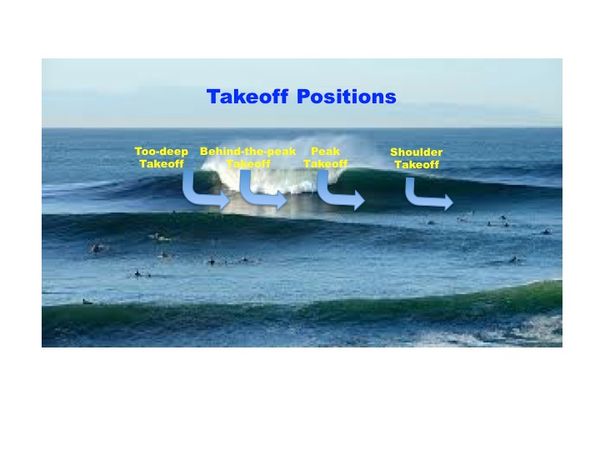Smart Positioning At Takeoff Creates Better Surfing
Many surfers could improve their performances simply by making better decisions when paddling for waves and at takeoff. Positioning themselves where a wave initially breaks is the first step in a well-surfed wave. Understanding that there are different takeoff options is also important so that the surfer can challenge themselves by positioning as deep as possible and still perform a quality first manoeuvre of a ride.
Surfers can position themselves at takeoff in a number of ways:
Shoulder takeoffs are where surfers takeoff on the side of where a wave initially breaks. It usually results in a flat and less committed first manoeuvre, unless….. the surfer fades back on takeoff to create a deeper entry into their first manoeuvre.

Taking-off behind the peak, or behind the initial section of a wave is the most challenging takeoff option for surfers. This places the surfer in a deep position from which they can perform a critical first manoeuvre. Often surfers will have to drive horizontally across the wave initially to make the section before dropping down to perform a deep set-up bottom turn leading to their 1st manouvre of the ride.
Surfers can also takeoff too-deep which negatively results in them missing the first manoeuvre of the ride because they get caught behind the first section. Although they may eventually get onto the open face, missing the first manoeuvre opportunity of a ride diminishes the value a wave offers a surfer.
Taking-off on a closeout wave is a common problem – especially in crowded surf situations. Closeout takeoffs result in limited manoeuvre opportunities, reducing the enjoyment of the ride.
Sometimes surfers takeoff on a wave too-late. That is they attempt to takeoff under the lip, with the lip breaking on their back as they attempt to drop down the wave face. Although surfers sometimes can make the drop, often when they do, their bottom turn is compromised and a lessor first manoeuvre is displayed.
Surfers should try be trying to takeoff on the peak or behind-the-peak only, and say “no” to all other takeoff options. Becoming decisive in this critical area will enhance the confidence of a surfer and improve all other areas of performance in the process.
